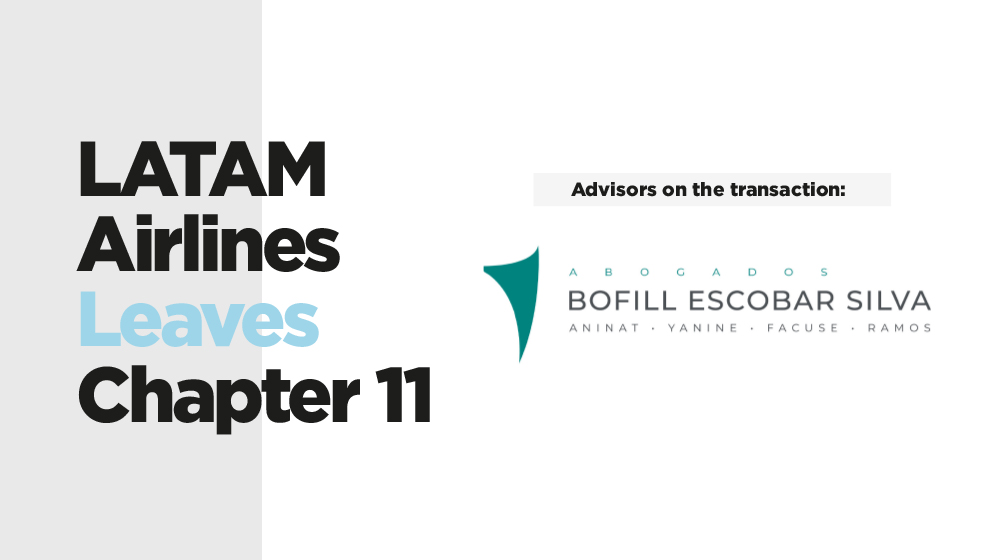The airline was left with $2.2 billion of liquidity and a debt reduced by $6 billion, or 35%. The operation involved a total of $16 billion in liabilities and 38 debtors, including the airline’s passenger and cargo subsidiaries.
Based out of Santiago, Chile, LATAM was created through the merger of Chilean and Brazilian airlines LAN and TAM in 2012. It filed for restructuring under Chapter 11 in May 2020 after a loss in demand created by COVID-19 pandemic restrictions and began raising funds to stay afloat. In June 2022 the airline received court approval for an $8 billion capital increase, including exit financing, which it had raised through the issuance of convertible bonds.
To facilitate the completion of the Chapter 11 process, LATAM obtained an exit financing package for a total of $4.25 billion. This included a $500 million revolving credit facility and a $1.1 billion five-year term loan, in addition to a bond issue in two tranches for a total of $1.15 billion. These tranches will mature in 2027 and 2029 respectively. LATAM was also awarded two bridge loans for a total of $1.5 billion, which will mature in five and seven years from the restructuring closing date of 18 October 2022. LATAM Airlines used the funds obtained to settle its existing debtor-in-possession lines of credit, with the remainder used for general corporate purposes.
Local bondholders were supported by White & Case, while the official committee of unsecured creditors was represented by Dechert. The ad hoc group of claimants (who are now LATAM’s largest shareholder, as a group) were advised by Kramer Levin Naftalis & Frankel in the US, and by the Santiago-based firm Bofill Escobar Silva Abogados. Coeymans, Edwards, Poblete & Dittborn also advised the ad hoc group.
Bofill Escobar Silva Abogados advised the claimants with a team comprising partners Jorge Bofill, Ricardo Escobar, Vanessa Facuse and Sebastián Yanine, as well as associates Cristóbal Cibie, Mirenchu Muñoz, Stefan Goecke, Sebastián Contreras and Sebastián Bofill.
Jorge Bofill, Bofill Escobar Silva Abogados:
Please tell us more about the role your team played during the restructuring process.
Our team oversaw all Chilean legal issues and provided strategic advice for the ad hoc group of claimants. Eventually, the ad hoc group of claimants became the largest holder of LATAM claims in the Chapter XI procedure, to the extent it had the ability to singlehandedly approve or reject any reorganisation plan proposed by LATAM.
From very early on, we engaged Arturo Poblete and his team from Coeymans, Edwards, Poblete & Dittborn to assist with the corporate law and securities law aspects of the advice, while we took the lead on the cross-border insolvency issues. Our team also assisted with anti-trust, insolvency and civil procedural law and tax law analysis, especially during the design and implementation of the plan.
Why was Bofill Escobar Silva Abogados a good fit for advising the claimants? What specialised skills and experiences did your team bring to the role?
The needs of our client required addressing a myriad of highly technical issues. We advised in the use of barely tested cross-border insolvency rules, the paths for enforcement of a foreign reorganisation plan, the structuring of new financing for the debtor during the Chapter XI proceedings, the backstopping of the debtor’s exit financing, the negotiation of support for the debtor’s reorganisation plan, among other major tasks that required involving experts from all our firm’s practices, who all rose to the occasion.
This speaks very highly of the diversity and quality of our professionals, and their strong international background, which is at the heart of our firm’s well-known expertise in complex cross-border cases.
The vast experience of our cross-border litigation team in the recognition and enforcement of foreign judgments, insolvency-related measures and arbitral awards proved critical in assessing the strength of each party’s position during the plan’s negotiation phase. In addition, our international mindset and excellent specialty practices like anti-trust, administrative law and tax helped the ad hoc group of claimants to understand and negotiate agreements effectively with the various parties involved. This was something we could only do thanks to our firm’s boutique approach to clients, which significantly reduces the potential for conflict of interest.
The needs of our client required addressing a myriad of highly technical issues.
What are the key considerations to take into account while advising ad hoc claimants during a large restructuring such as this?
The key objective was recovery for our client, the ad hoc group of claimholders. In achieving this, financial and commercial considerations tend to drive negotiations, but any proposal must first be structured in a legally feasible and practical way, and then once accepted, the agreement must be documented and implemented impeccably.
In this exercise, key considerations include reconciling conflicts between laws of the jurisdictions involved, accurately estimating the process and timing for implementation, navigating government agencies, documenting agreements that protect your client and anticipating and mitigating risks of all sorts.
Beyond these basic concerns, did you encounter any noteworthy challenges during the course of the restructuring? If so, how did you overcome them?
The biggest challenge was producing a reorganisation plan that reconciled two very different legal systems in matters of shareholder rights and public policy limitations, and that afforded creditors their fair share of payment.
Under US federal bankruptcy law, creditors are entitled to full payment before any shareholder recovers anything. This rule is called the ’absolute priority rule’ and because it belongs to a federal statute, it trumps the corporate law of a state. Since shareholder rights are a matter of state law in the US, these are overridden by the absolute priority rule. Thus, in a US reorganisation, voting quorums and pre-emptive rights of shareholders are not an obstacle for the implementation of a plan of reorganisation.
However, implementing in Chile a reorganisation plan that involved overriding Chilean shareholder rights was uncharted territory. While strong legal arguments may have ultimately led to successful enforcement of the plan in Chile, there were material risks of delays based on a potential expansive interpretation of public policy controls by lower-tier courts on implementation of foreign cross-border insolvency measures and reorganization plans.
On this issue, our firm played a key role in assessing the strength of the ad hoc group of claimants’ position if they pursued a reorganisation plan on their own and its ensuing implementation in Chile. This helped in convincing LATAM and other parties that this was a feasible alternative that our client was prepared to undertake if LATAM chose not to accommodate the ad hoc group of claimants’ expectations in the debtor’s reorganisation plan. Ultimately, our client and LATAM found common ground and the ad hoc group of claimants supported LATAM’s reorganisation plan.
Our firm played a key role in assessing the strength of the ad hoc group of claimants’ position
How did you work with the other firms involved to ensure that all parties were left satisfied by the proceedings?
Not all parties were left satisfied with the proceedings. Our role was to assist Kramer Levin in the push for a reorganisation plan that was feasible under US and Chilean law, and that gave the ad hoc group of claimants the best value they could get, understanding that an impairment of their claims was inevitable.
This involved talks with legal and financial advisors to parties with opposing interests. Our focus in these conversations was in assessing the strength of the other parties’ positions and curbing their expectations through providing them with recurrent reality checks.
Likewise, we provided the ad hoc group of claimants with legal advice that provided the necessary confidence in their position to push for better terms from LATAM, who was brokering the deal for a reorganisation plan with all parties involved.
What effect do you anticipate the restructuring will have on LATAM Airlines, its stakeholders and the wider aviation industry?
The airline’s high executives explained that the reorganisation plan ensures LATAM’s long-term sustainability, and that the airline emerged from the reorganisation with a strengthened financial position and its unrivaled connectivity network in South America. Analysts explained that LATAM emerged as a more efficient group, leaner and with a modernised fleet, with the most extensive connection network and loyalty program in South America.
I can imagine this does not please LATAM’s competitors, but one would expect this to be good for the industry, as it will be pressed to continue improving.
From the stakeholders’ side, the reorganisation plan meant a considerable change in its shareholder structure. A large group of creditors accepted convertible notes in payment of their claims, and many invested new money in LATAM together with other parties. The success of these bets is tied to LATAM delivering on its business plan, which was key in determining the economics of the reorganisation plan.
[ymal]
Do you have any other comments to make on this operation?
In my view, the reorganisation proceedings laid bare critical shortcomings of the Chilean insolvency system, which hopefully leads to its revision. My focus would be in allowing additional time to reach a reorganisation agreement for cases of higher complexity, and to include UNCITRAL-based regulation that allows swift implementation of foreign reorganization plans.





















